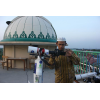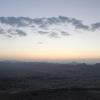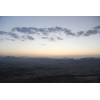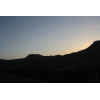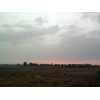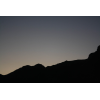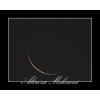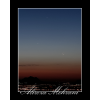Visibility of Dhul Qeadah Crescent 1435 AH
- When to Observe Dhul Qeadah Waxing (NEW) Crescent ?
- Dhul Qeadah Waxing (NEW) Crescent Observation Results
- The OFFICIAL First Day in Different Countries
- When to Observe Shawwal Waning (OLD) Crescent ?
- Shawwal Waning (OLD) Crescent Observation Results
When to Observe Dhul Qeadah Waxing (NEW) Crescent ?
The geocentric conjunction (Geocentric New Moon) will occur Inshalla on (Monday 25 August 2014) at 14:13 UT.
Sighting the new crescent on (Monday 25 August 2014) and (Tuesday 26 August 2014) is shown in the below graphs using the program Accurate Times by Mohammad Odeh according to Odeh criterion. Where:-
- It is impossible to see the crescent from the areas located under the red color. Because either the Moon on this day sets before the Sunset and/or the topocentric conjunction occurs after the Sunset.
- The crescent is expected to be seen by optical aid only from the areas located under the blue color.
- The crescent is expected to be seen by optical aid from the areas located under the magenta color. In these areas the crescent could be seen by naked eye if the atmospheric conditions are superb and the observer is experienced.
- The crescent is expected to be easily visible by naked eye from the areas located under the green color.
- The crescent cannot be seen from uncolored areas, even though the Moon sets in these locations after the Sunset and the topocentric conjunction occurs before the Sunset, but the Moon is not sufficiently illuminated in order to be seen as crescent even by optical aid.
- Kindly notice that the below graph shows the possibility of seeing the crescent from areas between 60 degrees north of Equator down to 60 degrees south of Equator.


According to the Universal Hejric Calendar (UHC), which is based on the calculated crescent visibility, the start of this month in the Eastern Region will be on Wednesday 27 August 2014 and in the Western Region will be on Wednesday 27 August 2014. Kindly notice that the UHC is a pre-calculated calendar, which adopts a certain criterion to start the new Hejric month. Your country/organization might adopt different criterion to start the new Hejric month. So it is highly advised to read the UHC website before giving any judgment.
- Results of seeing the crescent, and the first day of the month in different countries will be added here Inshalla as we receive the reports from ICOP's members. If you wish to be a member in ICOP, or to know more about it, kindly click here.
Dhul Qeadah Waxing (NEW) Crescent Observation Results
Tue 26 August 2014
Australia
Bangladesh
Egypt
Ghana
Mr. Baba Abdulai said: "Sky was cloudy since morning after a heavy rain (7 am to 10 am +). Sun was hidden behind clouds all day. Not even stars could be seen in the cloudy sky. Sighting community (Kukuo-Yapalsi, near Bi-Water Reservoir)."
Indonesia
Mr. AR Sugeng Riyadi said: "The new crescent of ThulKeadah 1435 AH was NOT SEEN on Monday August 26, 2014 from Assalaam Observatory, Sukoharjo-Surakarta Central Java Indonesia. The west horizon was partly cloudy and hazy. We are about 45 students of CASA (Club Astronomi Santri Assalaam) The Islamic Modern Boarding School ASSALAAM and two students of SMA Al-Islam 1 Surakarta."
Iran
Mr. Hossein Janghorbani said: " “In the name of God” Thul Kea'dah Crescent Observation Report Astronomy and Geophysics Center of Shahreza – The Crescent Association of Shahreza Report by: Hossein Janghorbani (Najm-al-Sepehr) – Manager of Shahreza Crescent Association and Red Crescent’s Astronomy and Geophysics Center Date: Tuesday, 08/26/2014 Location: Damzad Mountaintop beside the historic Tower Senbandy in the East of Shahreza (latitude: 32 00 N, longitude: 51 52 E, elevation: 2325m from sea level, time zone: +4.5 GMT) Equipments: two sets of 15*70, one compass. Atmospheric condition: partly cloudy and hazy in western horizon. Horizon obstacles: 0° Apparent sunset: -- Actual sunset: 19:34 Results: The crescent moon was not seen because of the partly cloudy and hazy in the western horizon. Observers:1.Sayed Mooslem rezvani 2.Sayed Abolfazl Kahangi 3.Mohammad Javad Nikeghbal 4. Hoosein janghorbani 5.Reza janghorbani 6.Shakiba moslehi 7.Zinat Ghermezi 8.Ziba Hafar "
Eng. Ali Janghorbani said: "Observers: 1.Sayed Farzad Alavi 2.Alireza Mojiri 3.Ali Janghorbani 4.Mohadeseh Alinejad 5.Mahsa Khajeh 6.Reyhaneh Dadvand 7.Zahra Farokhpoor 8.Fatemeh Tavakoli 9.Naiemeh Sadat Saniei 10.Mrs.Hadad"
Jordan
Morocco
Dr. Hassan Talibi said: "رؤية الهلال في المغرب ممتنعة حسب النتيجة الحسابية لوزارة الأوقاف ولذا فمطلع ذي العقدة سيكون يوم الخميس إن شاء الله. ( ينظر الوثيقة المرفقة."
Nigeria
Dr. Z.Sani Mustapha said: "The thin crescent as seen and immediately was covered by dark cloud."
Mr. Yunusa Yakubu said: "It was a very clear atmospheric condition. the sun sets 12 min earlier behind thin cloud it was a perfect condition for moon sighting and the moon was just not there to be sighted. However, according to Nigerian official counting today is 1st of Qul-K'ada not to talk of even 30th Shawwal. The ICOP should please reach out to the authorities in Nigeria for an enlightment. "
Oman
Prof. Mohammed Al-Bussaidi said: "The Crescent Moon was sighted in the morning using a CCD camera. The challenge is to sight the same Crescent Moon today after sunset."
Prof. Mohammed Al-Bussaidi said: "After tracking the Crescent Moon with the telescope + CCD for almost from morning until sunset. The crescent was seen and photographed until (sunset + 1 minute) then the crescent Moon went behind a thick black clouds. "
Saudi Arabia
Dr. Ayyub Patel said: "According to google sky map the moon was above he western horizon at and after sunset for about 25 min. There were lots of clouds on the horizon. The crescent moon sighting was attempted after magrib prayers but it was not seen. According to the visibility map for this region it wasn't going to be sighted and it was proved to be correct."
Tanzania
Mr. Zaffar Sheriff said: "Part cloudy and hazy western horizon prevented us to sight the 25 hour old crescent. Altitude of 8.7 would have posed a challenge. No sighting reports were received from any other city in Tanzania."
United States
Dr. Javad Torabinejad said: "I arrived at my sighting location (Blacksburg Middle School) before sunset (sunset: 7:58 pm EDT). Soon after, using binoculars (7X50 and 10X50), I started scanning the partly cloudy western horizon with no success. Mercury was visible, however. I stayed there past moonset (moonset: 8:22 pm)."
Wed 27 August 2014
Egypt
Mr. AbdelHamid Ahmed said: "بدأت الرصد بعد الغروب وتمت رؤية الهلال من الساعة 7:35م الى 8:7 م وكان ارتفاع الهلال عند الرؤية الاخيرة درجتين وربع واختفى وراء المباني كل عام وانتم بخير"
Germany
Eng. Martin Elsaesser said: "The sky cleared in the afternoon but the crescent was low on the horizon after sunset where some clouds remained. As the crescent was very wide it was easy to see with the imaging system despite the clouds. I could also see it clearly with 12x50 binoculars, just observing from the open kitchen window. I tried repeatedly to see it with the naked eye but could not see it clearly enough to be sure. With binoculars it was very certain."
Netherlands
Mr. Sander Helmig said: "Because of the clouds, I couldn't see the cresent."
Nigeria
Mr. Yunusa Yakubu said: "It was a cloudy condition contrary to what was obtainable yesterday. I was at the location 18hrs an the sun sets 18:05 behind thick cloud cover and I left the location at 19:20. However, I got a report of positive sighting by Mallam Aminu from Takin Fulani villege in Lim ward of Bununu District of Tafawa Balewa LG, Bauchi Nigeria. The number of people is over fourty (40)."
Saudi Arabia
Dr. Ayyub Patel said: "Unfortunately, i fell asleep so could not go out in time. I woke up for magrib prayer some 20 min. late and from my house window towards the western sky i did get a good glimps of the waxing crescent in bettwen the heavy clouds. It quickly disappeared behind the clouds and as the clouds were large and thick, i did not get another observation. According the the ummul qurah calendar, wednesday was the first of DhulQa'dah. The next day, i was on my way to perform umra and i saw the crescent and took good pictures near Yalamlam Miqat some 140km south of Makkah."
United States
Dr. Javad Torabinejad said: "I arrived at my sighting location at 7:51 pm EDT (sunset: 7:57 pm). Using a pair of binoculars (7X50), I scanned the western horizon. At 7:52 pm, I saw the crescent first with the pair of binoculars and then with naked eye. The sky was clear but hazy. The horns were at 1:30 and 6:00 O'clock (1:30;3:00;6:00). I followed the crescent till 8:42 pm when it was about to disappear behind trees and a building (moonset: 8:53 pm)."
The OFFICIAL First Day in Different Countries
Tue 26 August 2014
1 . Indonesia
Wed 27 August 2014
1 . Netherlands
2 . Oman
3 . Saudi Arabia
Thu 28 August 2014
1 . Australia
2 . Bangladesh
3 . Iran
When to Observe Shawwal Waning (OLD) Crescent ?
The geocentric conjunction (Geocentric New Moon) will occur Inshalla on ( Monday 25 August 2014 ) at 14:13 UT.
Sighting the OLD crescent on ( Monday 25 August 2014 ) and on ( Sunday 24 August 2014 ) is shown in the below graphs using the program Accurate Times by Mohammad Odeh according to Odeh criterion. Where:-
- It is impossible to see the OLD crescent from the areas located under the red color. Because either the Moon on this day rises after the Sunrise and/or the topocentric conjunction occurs before the Sunrise.
- The crescent is expected to be seen by optical aid only from the areas located under the blue color.
- The crescent is expected to be seen by optical aid from the areas located under the magenta color.. In these areas the crescent could be seen by naked eye if the atmospheric conditions are superb and the observer is experienced.
- The crescent is expected to be easily visible by naked eye from the areas located under the green color.
- The crescent cannot be seen from uncolored areas, even though the Moon rises in these locations before the Sunrise and the topocentric conjunction occurs after the Sunrise, but the Moon is not sufficiently illuminated in order to be seen as crescent even by optical aid.
- Kindly notice that the below graph shows the possibility of seeing the crescent from areas between 60 degrees north of Equator down to 60 degrees south of Equator.


Shawwal Waning (OLD) Crescent Observation Results
Sun 24 August 2014
Germany
Eng. Martin Elsaesser said: "I tried to see the crescent before sunset but the weather was to cloudy, despite waiting outside for almost an hour. Around noon we got a few gaps in the clouds and i could easily observe the crescent for a few minutes with a very minimal imaging system using only a small lens and a simple tripod. With a good telescope this could probably have been seen visually."
Ghana
Mr. Baba Abdulai said: "Must have been between 5:05 to 5:25 am when I saw the crescent. Fajr was at 4:50 am and i saw the crescent after Fajr."
Iran
Iraq
Dr. AbdulSattar M. Khidhir said: "تم اخذ عدة صور للهلال وتم معالجة احداها ببرنامج الفوتوشوب خيار filter->sharpen-> smart sharpen الصور المرفقة معكوسة افقيا "
Netherlands
Mr. Sander Helmig said: "I tried to see the crescent before sunrise but i couldn't find it because of the clouds. "
Nigeria
Dr. Z.Sani Mustapha said: "The sky has been cloudy for most of the day and night."
Saudi Arabia
Dr. Ayyub Patel said: "on the 24th of august after teh fajr prayers in the local mosque at 4.50am locla time i observed the waning shawwaal crescent moon. Picture is attached. Likewise i also observed the wannin crescent on the two days prior to this day."
Mon 25 August 2014
Indonesia
Mr. AR Sugeng Riyadi said: "On Monday: August 25, 2014 the old crescent of Shawwal 1435 AH was NOT SEEN because the east horizon was partly cloudy and hazy."
